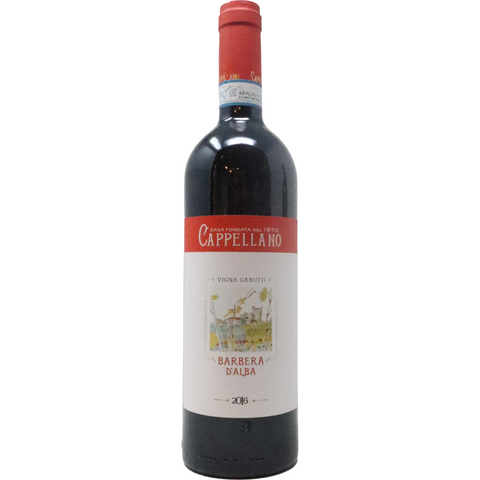
2019 Cappellano Barbera d'Alba "Gabutti", Piedmont, Italy
The 2019 Cappellano Barbera d'Alba "Gabutti" is a beautifully expressive red, offering intense aromas of ripe cherries, plums, and blackberries, intertwined with subtle hints of leather, licorice, and wild herbs. On the palate, it is juicy and vibrant with a balancing acidity, showcasing layers of dark fruit, savory spices, and a touch of earthiness. The wine is well-structured with soft tannins and a long, lingering finish.
ABOUT THIS WINE
Another great Piemonte vine, another great aspect of the Gabutti vineyards. A classic Barbera, feminine in its generosity and masculine in its posture. It is characterised by a distinctive acidity which sustains softness and fruit, and delivers a vibrating tasting experience until the long finale. The wine gives the impression of partial incompleteness, of continuous change; like all the red wines with strong character it takes its time to unveil its potentiality, character, and pleasures. Needless to say, only a natural conduct and the artisanal attitude enables Cappellano to produce an authentic Barbera, always recognisable but never identical, familiar yet surprising thanks to the ability to evolve as a narration, where the years take the place of the pages.
ABOUT THIS PRODUCER
Barolo is an area where fiercely independent people make extraordinary wines. Yet, even in such company, Teobaldo Cappellano, who passed away on February 21, 2009, stood out for his unique philosophy, his meticulous winemaking and the profound character of his wines.
A legend in Barolo—and among artisanal growers throughout Italy—Cappellano was one of the last of the region’s great traditionalist winemakers—and he was one of Barolo’s most compelling personalities. In 1983 he banished all journalists from his cellar, unless they agreed to review his wines without scores. (He saw ratings as divisive among growers.) And he may have been the only person who, during his lifetime, made a Barolo from ungrafted vines.
With his passing, his son Augusto will continue Teobaldo’s important work, which includes producing the family’s renowned Barolo “Piè Franco” and Barolo “Rupestris”
Revered in the Langhe
The near-universal admiration accorded Cappellano was striking, given that his attitudes were often controversial. Variously described as a “wine artist,” “professional polemist,” and a “poet, philosopher and winemaker in his spare time,” he was president of the influential Vini Veri (or “true wine”) group. He was also a longtime leader of Italy’s sustainable agriculture movement.
Cappellano has been compared to Bartolo Mascarello, both as a beloved figure and in the depth of his views. And his Barolos were just as firmly rooted in local traditions as were the late Mascarello’s.
Cappellano made fewer than 800 cases of Barolo per year, all vinified traditionally: a fermentation of 14 to 21 days with indigenous yeasts and aging in well-seasoned botti for at least three years. His tiny production quickly disappeared into collectors’ cellars in Italy, Switzerland and Germany. As Antonio Galloni once wrote, “Cappellano’s wines are impossibly hard to find, even in neighboring Alba.”
Classic Winemaking
The Barolos that Cappellano made are classic “old-style” wines, marked by a haunting scent of dried roses and a hint of truffle. Yet, because of his stance on ratings, little has been written about them in America.
He made two Barolos—both from the mythic Gabutti vineyard on Serralunga’s best slope. (A few years ago, he removed the Gabutti designation from his labels to protest the expansion of the appellation to include inferior sites.)
Two-thirds of his Barolo production was Barolo “Rupestris,” from a parcel planted on grafted rootstock in the 1940s. The grapes from this parcel produce a Barolo of superb depth of color and remarkable richness and length.
His other Barolo was the mythic “Piè Franco,” from a parcel planted on its own roots with Nebbiolo’s “Michet” clone in 1989. The ethereal delicacy of this great wine made Cappellano wonder if this is what Barolo tasted like before Phylloxera.
He also continued his family’s tradition of making a small amount of their legendary elixir, Barolo Chinato, an infusion of Barolo with quinine bark, clove, wormwood and cinnamon and a small amount of cane sugar.
For Cappellano, winemaking was an art. As he told Maurizio Rosso in The Mystique of Barolo, “Making Barolo is hedonism, it is art. Wine is hedonism. But wine, too, needs identity: I need to be able to say “This is Barolo.”
